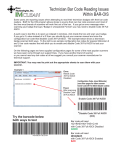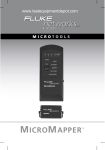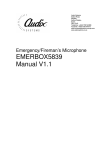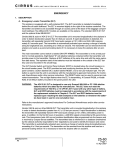Download Shure VP88 User guide
Transcript
Model VP88 User Guide FEATURES GENERAL DESCRIPTION The Shure Model VP88 is a single-point, stereo condenser microphone for use in professional studio recording, field production, electronic news gathering (ENG), and studio broadcasting applications. It combines two condenser cartridges in a single housing to create a stereo audio image of the sound source. It is unique in its ability to capture the realism of a live event and yet withstand rigorous field production environments. The VP88 uses a mid-side (M-S) configuration. One microphone cartridge (Mid) faces forward to capture on-axis sound using a cardioid pickup pattern. The other microphone cartridge (Side) is bi-directional, capturing sound from either side. The VP88 contains an internal M-S matrix with three settings for different degrees of stereo image seperation. The internal matrix can be bypassed if an external matrix is used or if stereo imaging is done in post-production. Switches on the top of the microphone control output mode, stereo imaging, low-frequency rolloff settings, and battery on/off. The VP88 can operate on phantom power or an internal 6V battery. The VP88 is supplied with a multi-connector “Ysplitter” cable, foam windscreen, swivel stand adapter, 6-volt battery, and zippered carrying/storage bag. Optional accessories include an isolation mount, a 7.6 m (25 ft) microphone extension cable, a phantom power supply, and a 4.3 m (14 ft) microphone stand. 2001, Shure Incorporated 27B3043 (AH) • Time-coherent, Mid-Side (M-S) design for optimal stereo imaging • Built-in stereo matrix for direct control of the stereo spread; direct M-S outputs available • Mono compatibility ideal for broadcast applications • 40 to 20,000 Hz frequency response • Low noise and distortion • Wide dynamic range • Switch-selectable, low-frequency rolloff (12 dB/octave below 80 Hz) for reduced pickup of ambient noise and stand vibration • Operates on phantom power or a 6V camera battery • LED power indicator • Internal shock mount for reduced stand vibration and handling noise • Built-in “pop” screen • Rugged construction • Windscreen, swivel adapter, and Y-cable included MOUNTING The VP88 can be mounted on a standard microphone floor stand, fishpole or boom. Make sure the front of the grille faces the sound source and the top of the microphone faces up, so that the the resulting stereo image matches the left and right components of the sound source A88SM External Shockmount The optional A88SM Shock Mount provides optimum isolation from stand-transmitted shock and vibration. The A88SM is ideal for critical studio applications contains a standard mounting foot for use with most electronic news gathering (ENG) video cameras. POWER Phantom Power The VP88 can be phantom powered by any microphone mixer or console providing 9 to 52 Vdc phantom power, or by a phantom power supply such as the Shure PS1A. Each balanced audio cable pair (pins 2 and 3: Mid/Left; pins 4 and 5: Side/Right) carries the supply current to the microphone, and the cable shield (pin 1) is the ground return. The Mid or Side output can be used individually with either phantom or battery power. When operating in the Stereo mode without battery, both Mid/Left and Side/Right outputs must be phantom powered. Printed in U.S.A. Battery Power If phantom power is not available, turn the Battery On/Off control to the Batt On position. The adjacent LED will flash momentarily, indicating that at least five hours of useful battery life remain. If the LED does not flash, the battery should be replaced. When the VP88 is set for stereo mode operation (H, M, or L), the left and right signals should remain fully seperated and kept at equal levels to maintain a balanced stereo effect. NOTE: If phantom power is applied with the control in the Batt On position, there will be no battery drain. USING AN ADDITIONAL MICROPHONE A second (mono) microphone can be used for interviewing or close miking. Turn its channel pan pot to the center position and set its level independently. NOTE: Use the Shure C110 Extension Cable (available as an accesory) for extended cable runs between the VP88 and the mixer or console. Installing and Replacing the Battery The VP88 uses a 6V cylindrical camera battery available at most camera shops. Average battery life depends on the type of battery: 70 hours is typical for silver oxide or lithium batteries, 40 hours is typical for alkaline batteries. A list of replacement batteries is presented in the following table. SPEC. AGENCY/ MANUFACTURER SILVER OXIDE LITHIUM MANGANESE ALKALINE NEDA IEC Duracell Eveready Kodak Panasonic Radio Shack Varta 1406SOP 4SR44 PX28 544 KS28 4G13 – V28PX 5005L 2CR1/3N PX28L L544 K28L – – V28PXL 1414A 4LR44 – A544 K28A 4LR44 23–469 V4304PX MONITORING Monitor sound in mono mode, as well as in stereo, to check the balance for the mono listener. The mono output will be equal to the cardioid Mid cartridge signal only, regardless of the side level control setting, since the side signal is cancelled in mono. PREVENTING WIND NOISE The integral wind and pop filter provides protection against moderate breath or wind noise. Use the supplied windscreen in high wind conditions, or with “problem” talkers. LOW-FREQUENCY ROLLOFF A low-frequency rolloff (12 dB per octave cut below 80 Hz) rolloff can be useful in reducing pickup of low-frequency noise and vibration. To install or replace the battery, proceed as follows: Set the upper control switch on the VP88 to either of the two low-frequency rolloff positions, depending on whether phantom or battery power is being used. See Figure 1. 1. Disconnect the microphone cable and unscrew the VP88 lower handle. 2. Carefully slide the lower handle away from the grille, exposing the battery compartment. If necessary, remove the old battery. PHANTOM (BATT OFF) BATT ON PHANTOM (BATT OFF) BATT ON 3. Insert the new battery, observing the polarity marking in the battery compartment. Rolloff with Phantom Power 4. Slide the lower handle back into position and tighten. CONNECTIONS Rolloff with Battery On ROLLOFF SELECTION SWITCH FIGURE 1 Use the supplied Y–splitter cable to connect the VP88 to two inputs of a mixer or console. The red connector, marked “M” and “L”, carries the Mid signal (in MS mode) or left signal (in stereo mode). The green connector, marked “S” and “R”, carries the Side signal (in MS mode) or right signal (in stereo mode). OUTPUT MODE The lower control sets the VP88 to either MS Mode or to one of three Stereo modes. (L, M, or H). See Figure 3. For stereo mode operation, connect the left (L) splitter connector to the Channel 1 input and the right (R) splitter connector to the Channel 2 input of the mixer or console. Set the Channel 1 pan pot to full left and the Channel 2 pan pot to full right. MS L O H M E R ST E SIDE LEVEL OUTPUT MODE SELECTION SWITCH FIGURE 2 2 Stereo Output Mode In Stereo Mode, the VP88 uses its internal matrix to mix the Mid and Side signals and provide Left and Right stereo outputs. The three settings (H, M, and L), determine the strength or width of the stereo effect, as described below. Nominal Left and Right pickup patterns are shown in Figure 3. In the L position, the microphone also picks up the least amount of ambient sound from the side, and can be used to reduce high ambient noise or reverberation. The L setting can be useful if the area being miked is already very wide. However, the degree of stereo effect may be compromised in narrow performing areas. NOTE: The mono sum (Left + Right) in any Stereo position is always equal to the Mid signal, ensuring mono compatibility. M (Medium): Side level is 1.9 dB lower than Mid level. The increased side ambience pickup and stereo spread make the M setting ideal for most applications. L (Low): Side level 6.0 dB lower than Mid level. The stereo image spread of the stereo images is small. Use this setting for distant miking, or in situations where the microphone directionality cannot be well controlled, such as hand-held use. H (High): Side level is1.6 dB higher than Mid level. The H position provides the most side ambience pickup and the greatest amount of stereo spread. This setting is only appropriate if a high degree of ambience pickup is acceptable and the performing area is not excessively wide. LOW STEREO (L) MEDIUM STEREO (M) 30o 30o 60o 60o 90o 90o 30o 60o 90o 90o 60o 90o 90o –20 dB –15 dB 120o –10 dB 120o –15 dB 120o –10 dB –5 dB 120o 150o –5 dB 150o 150o 120o –10 dB –5 dB 150o 150o 180o 180o 30o 60o –20 dB –15 dB 150o 0 30o 60o –20 dB 120o HIGH STEREO (H) 0 0 30o 180o NOMINAL PICKUP PATTERNS FOR STEREO OUTPUT MODE FIGURE 3 0 MS Output Mode 30o In MS mode, the VP88’s internal stereo matrix is bypassed. The signal from the mid cartridge is sent to the red connector on the Y-splitter cable (M) and the side cartridge output is sent to the green connector (S). The Side on-axis sensitivity (90° from the front axis of the microphone) is 1.6 dB higher than the on-axis sensitivity of the Mid output. The sensitivities of the Mid and Side outputs are equal at 45° off the front axis of the microphone. The polarity of the left lobe of the Side output matches the polarity of the Mid output. The right lobe of the Side output is opposite polarity. See Figure 4. 30o 60o 60o 90o 90o –20 dB –15 dB 120o 120o –10 dB –5 dB 150o 150o 180o NOMINAL PICKUP PATTERNS FOR MS OUTPUT MODE FIGURE 4 EXTERNAL MATRIXES Results similar to the Medium (M) and Low (L) settings can be obtained by attenuating the side signal before matrixing. When using an external stereo matrix, such as a matrix transformer or active matrix circuitry, set the VP88 to MS mode (refer to the Output Mode paragraph). NOTE: An external matrix can be useful when recording, because decisions on stereo imaging are deferred to the post-production stage. Two suggested matrix boxes: The Mid and Side outputs can be processed through a sum-and-difference matrix to produce Left and Right stereo signals as follows: Left = Mid + Side Right = Mid – Side A 1:1 ratio of Mid to Side produces stereo signals identical to those obtained with Stereo Output switch set to High (H). Model MS38 DM Dual-Mode Line-Level MS Matrix or Model MS380 TX Stereo Microphone Preamplifier with Dual-Mode MS Matrix and Line Driver. Both are manufactured by Audio Engineering Associates, 1029 N. Allen Ave., Pasadena, CA 91104 U.S.A. 3 CIRCUIT DESCRIPTION A block diagram of the VP88 is shown in Figure 5. VP88 CIRCUIT BLOCK DIAGRAM FIGURE 5 Overvoltage Protection Maximum External Voltage applied to Pins 2 through 5 with respect to Pin 1: ±75 Vdc Polarity Positive pressure applied from any direction to the Mid cartridge or from the left to the Side cartridge in the MS mode, or applied from the front in the Stereo mode produces positive voltage on pin 2 relative to pin 3 (Mid/Left) and pin 4 relative to pin 5 (Side/Right). Power Phantom Supply Voltage: 9 to 52 Vdc Current Drain: 1.3 mA/output; 2.6 mA total Battery Type: 6 V cylindrical* Life: 70 hours** Current Drain: 2.4 mA total SPECIFICATIONS Type Single-point stereo (MS configuration) condenser Frequency Response (See Figures 6 and 7) 40 to 20,000 Hz Polar Pattern (See Figures 8 and 9) Mid Cartridge: Cardioid (unidirectional) Side Cartridge: Bidirectional Output Impedance Rated at 150 (100 Ω actual). Recommended minimum load impedance: 800 Ω (may be used with loads as low as 150 Ω with reduced clipping level) Sensitivity (1 kHz, MS mode) Open Circuit Voltage: –66 dB (0.5 mV) Mid. (Side level 1.6 dB higher than Mid level) (0 dB=1 V/Pa) Side Level (Stereo mode; relative to Mid level) Low: –6.0 dB; Medium: –1.9 dB; High: +1.6 dB Clipping Level (1 kHz) 800 Ω Load (less than 1% THD) –12 dBV (0.25 V)(Mid output, 1% THD) –10 dBV (0.30 V)(Side output, 1% THD) 150 Ω Load (less than 3% THD) –25 dBV (0.06 V)(Mid output) –19 dBV (0.11 V)(Side output) Maximum SPL 800 Ω Load: 129 dB 150 Ω Load: 119 dB Hum Pickup –4 dB equivalent SPL in 1 millioersted field (60 Hz) Self Noise (Mid, Side, Left and Right outputs; equivalent sound pressure levels) 24 dB typical, A-weighted 28 dB typical, weighted per DIN 45405 Dynamic Range 105 dB (maximum SPL to A-weighted noise level) Signal–to–Noise Ratio* 70 dB (IEC 651) at 94 dB SPL *Silver oxide (NEDA 1406SOP), lithium (NEDA 5005L), alkaline (NEDA 1414A) **Fresh silver oxide or lithium battery; 40 hours with alkaline Environmental Conditions Operating: –18° to 57° C (0° to 135° F) (Relative Humidity <90%) Storage: –29° to 74° C (–20° to 165° F) (Relative Humidity <80%) Cables (see Figure 10) Y-Splitter Cable (supplied): 0.76 m (30 in.) vinyl-jacketed, dual– shielded, 2-conductor with 5-pin female XLR connector on microphone end and two 3-pin male XLR connectors on equipment ends. Microphone Extension Cable (Model C110; optional): 7.6 m (25 ft.) vinyl-jacketed, shielded, 4-conductor with 5-pin male XLR connector on one end and 5-pin female XLR connector on other end. Case Brass and nickel-plated aluminum construction with stainless steel grille. Finished in satin black vinyl enamel Dimensions See Figure 11 Net Weight 417 grams (14.7 oz) less battery and cable *S/N ratio: difference between microphone output at 94 dB SPL and microphone self–noise A– weighted. 4













